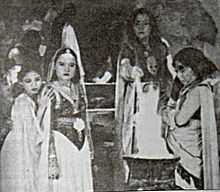Ratna Moetoe Manikam

Ratna Moetoe Manikam (Perfected Spelling: Ratna Mutu Manikam), also known by the title Djoela Djoeli Bintang Tiga (Dance of the Three Stars; Perfected Spelling: Jula Juli Bintang Tiga), is a film from the Dutch East Indies (now Indonesia).
The film follows three goddesses, the titular Ratna Mutu Manikam (Ratna Asmara) and her sisters Laila Kesuma and Kumala Juwita. Ratna and Kumala fall in love with a human king named Sultan Darsyah Alam (Astaman) and compete for his affections.[1] When Darsyah chooses Ratna, Kumala is furious and plots his destruction. Laila overhears Kumala's scheming and tells her elder sister, who in turn consults Batara Guru. The elder god tells Ratna that Darsyah is to be her soul mate. Using his magical ring named Ratna, Darsyah is able to avert Kumala's revenge.[1]
Ratna Moetoe Manikam was directed by Sutan Usman Karim, under the pseudonym Suska.[1] He had worked as an editor for the Padang-based daily Persamaan, and had directed Panggilan Darah (1941) for Oriental Film before joining The Teng Chun's New Java Industrial Film (JIF). The's company produced the film Ratna Moetoe Manikam. Inspired by the success of The Thief of Bagdad (1940), Suska realised that a modernised version of a classic story could be successful.[2] He therefore adapted the plot for Ratna Moetoe Manikam from a stage drama entitled Djoela Djoeli Bintang Tiga, a staple of stamboel stage performances.[2]
The film starred Ratna Asmara, Astaman, Ali Joego, and Inoe Perbatasari.[1] Ratna Asmara and Astaman shot their roles film concurrently with Andjar Asmara's Noesa Penida.[3] Hajopan Bajo Angin handled artistic direction.[4]
According to director Tan Tjoei Hock, filming was interrupted by the Japanese occupation in early 1942;[1] the Japanese forces closed all local production houses, including New JIF.[5] Tan reportedly finished filming the work by order of the Japanese overlords.[6] The Indonesian film historian Misbach Yusa Biran writes that it was released during the occupation, which lasted until 1945, but he does not specify a year.[6]
The film is likely lost. The American visual anthropologist Karl G. Heider writes that all Indonesian films from before 1950 are lost.[7] However, JB Kristanto's Katalog Film Indonesia (Indonesian Film Catalogue) records several as having survived at Sinematek Indonesia's archives, and Biran writes that several Japanese propaganda films have survived at the Netherlands Government Information Service.[8]
References
- ↑ 1.0 1.1 1.2 1.3 1.4 Filmindonesia.or.id, Ratna Moetoe Manikam.
- ↑ 2.0 2.1 Biran 2009, pp. 216, 276–277.
- ↑ Biran 2009, p. 278.
- ↑ Filmindonesia.or.id, Kredit.
- ↑ Biran 2009, p. 284.
- ↑ 6.0 6.1 Biran 2009, p. 218.
- ↑ Heider 1991, p. 14.
- ↑ Biran 2009, p. 351.
Works cited
- Biran, Misbach Yusa (2009). Sejarah Film 1900–1950: Bikin Film di Jawa [History of Film 1900–1950: Making Films in Java] (in Indonesian). Jakarta: Komunitas Bamboo working with the Jakarta Art Council. ISBN 978-979-3731-58-2.
- Heider, Karl G (1991). Indonesian Cinema: National Culture on Screen. Honolulu: University of Hawaii Press. ISBN 978-0-8248-1367-3.
- "Ratna Moetoe Manikam (Djoela Djoeli Bintang Tiga)". filmindonesia.or.id. Jakarta: Konfiden Foundation. Archived from the original on 27 July 2012. Retrieved 27 July 2012.
- "Ratna Moetoe Manikam (Djoela Djoeli Bintang Tiga) | Kredit" [Ratna Moetoe Manikam (Djoela Djoeli Bintang Tiga) | Credits]. filmindonesia.or.id. Jakarta: Konfiden Foundation. Archived from the original on 27 January 2013. Retrieved 27 January 2013.